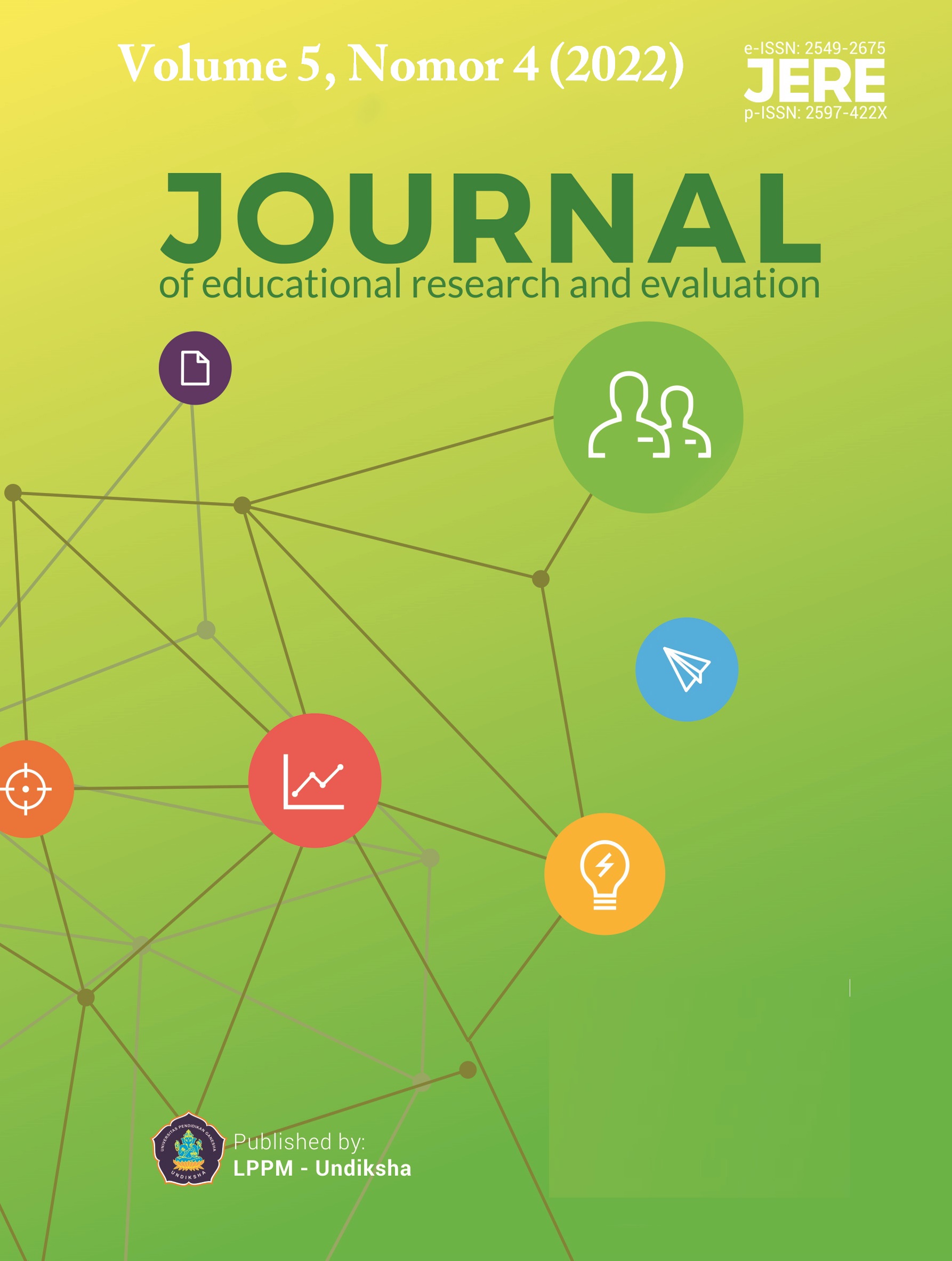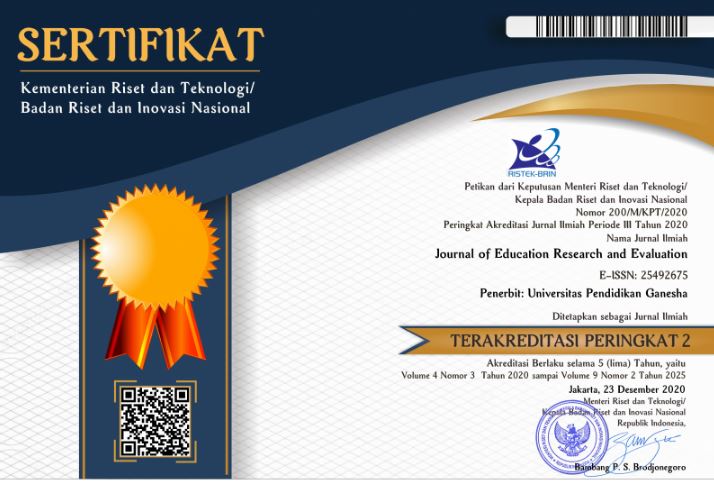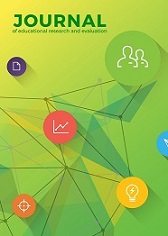Evaluation of the Results of Attitudes and Self-Efficacy of Middle School Students in Science Subjects
DOI:
https://doi.org/10.23887/jere.v5i4.36409Keywords:
Science, Attitude, Self-EfficacyAbstract
Good attitudes and self-efficacy in each student's personality are very important to have in order to maximize the activities and learning outcomes of each student. The urgency of this research as a reference to the educators in conducting teaching to find out the significant and continuous impact on the success of student achievement in science subjects and student performance on the variables of self-efficacy and attitude in learning. This study aims to determine the differences and the relationship between attitudes and self-efficacy of students in science subjects. The type of research is comparative quantitative. The number of respondents as a sample is 74 students. The data collection technique used simple random sampling. The results of the study using the T test, which is a significant difference in student attitudes in science lessons, both female and male students in class VII A and class VII B. From the results of the T test for self-efficacy, there are differences in student self-efficacy in lessons Science both students and male students in class VII A and class VII B. The results of the correlation test between students' attitudes and self-efficacy towards science subjects in class VII A and VII B showed that attitudes and self-efficacy were related. This study has limitations including researchers only measuring the attitudes and self-efficacy of students in class VII. Recommendations for further researchers can research or measure students' interests and motivations or make generalizations about this research.
References
Aharony, N., & Gazit, T. (2020). Students’ information literacy self-efficacy: An exploratory study. Journal of Librarianship and Information Science, 52(1), 224–236. https://doi.org/10.1177/0961000618790312.
Amrullah, A., Hadisaputo, S., & Supardi, K. I. (2017). Pengembangan Modul Chemireligiousa Terintegrasi Pendidikan Karakter Bervisi Sets. Jurnal Inovasi Pendidikan Kimia, 11(1), 1872–1883. https://doi.org/10.15294/jipk.v11i1.9715.
Anisa, A. (2017). Meningkatkan Keterampilan Berpikir Kritis Peserta Didik Melalui Pembelajaran IPA Berbasis Potensi Lokal Jepara. Jurnal Inovasi Pendidikan IPA, 3(1), 1–11. https://doi.org/10.21831/jipi.v3i1.8607.
Astalini., Kurniawan, Dwi. A., S., & Umaryanti. (2018). Sikap Siswa Terhadap Pelajaran Fisika Di SMAN Kabupaten Batanghari. Jurnal Ilmu Pendidikan Fisika, 3(2), 59–64. https://doi.org/10.26737/jipf.v3i2.694.
Astuti, I. A. D., Sumarni, R. A., & Saraswati, D. L. (2017). Pengembangan Media Pembelajaran Fisika Mobile Learning berbasis Android. Jurnal Penelitian Dan Pengembangan Pendidikan Fisika, 3(1), 57–62.
Asy’ari, M., Hidayat, S., & Muhali, M. (2019). Validitas dan efektivitas prototipe buku ajar fisika dasar reflektif-integratif berbasis problem solving untuk meningkatkan pengetahuan metakognisi Validity and effectiveness of reflective-integrative basic physics textbook prototype based on problem solv. Jurnal Inovasi Pendidikan IPA, 5(2), 205–215. https://doi.org/10.21831/jipi.v5i2.27089.
Bellová, R., Melicherčíková, D., & Tomčík, P. (2018). Possible reasons for low scientific literacy of Slovak students in some natural science subjects. Research in Science and Technological Education, 36(2), 226–242. https://doi.org/10.1080/02635143.2017.1367656.
Cahyanto, M. A. S., Ashadi, A., & Saputro, S. (2019). An Analysis of Gender Difference on Students’ Misconceptions in Learning the Material Classification and Its Changes. Jurnal Inovasi Pendidikan IPA, 5(2), 157–167. https://doi.org/10.21831/jipi.v5i2.26613.
Camasso, M. J., & Jagannathan, R. (2018). Nurture thru Nature: Creating natural science identities in populations of disadvantaged children through community education partnership. The Journal of Environmental Education, 49(1), 30–42. https://doi.org/10.1080/00958964.2017.1357524.
Darmaji, D., Kurniawan, D. A., & Irdianti, I. (2019). Physics education students’ science process skills. International Journal of Evaluation and Research in Education, 8(2), 293–298. https://doi.org/10.11591/ijere.v8i2.28646.
Dell’Aquila, D., & Russo, M. (2021). Automatic classification of nuclear physics data via a Constrained Evolutionary Clustering approach. Computer Physics Communications, 259, 107667. https://doi.org/10.1016/j.cpc.2020.107667.
Dewi, V. P., Doyan, A., & Soeprianto, H. (2017). Pengaruh Model Penemuan Terbimbing Terhadap Keterampilan Proses Sains Ditinjau Dari Sikap Ilmiah Pada Pembelajaran Ipa. Jurnal Penelitian Pendidikan IPA, 3(1). https://doi.org/10.29303/jppipa.v3i1.102.
Effendi, P., & Ratnasari, D. (2018). Kesetaraan Gender Dalam Prespektif Undang-Undang Nomor 13 Tahun 2003 Tentang Ketenagakerjaan. Jurnal Pro Hukum: Jurnal Penelitian Bidang Hukum Universitas Gresik, 7(2), 1–8. http://journal.unigres.ac.id/index.php/JurnalProHukum/article/view/701.
Fakhriyah, F., Masfuah, S., Roysa, M., Rusilowati, A., & Rahayu, E. S. (2017). Student’s science literacy in the aspect of content science? Jurnal Pendidikan IPA Indonesia, 6(1), 81–87. https://doi.org/10.15294/jpii.v6i1.7245.
Firdaus, M., & Wilujeng, I. (2018). Pengembangan LKPD inkuiri terbimbing untuk meningkatkan keterampilan berpikir kritis dan hasil belajar peserta didik. Jurnal Inovasi Pendidikan IPA, 4(1), 26–40. https://doi.org/10.21831/jipi.v4i1.5574.
Fraile, M., & Gomez, R. (2017). Bridging the enduring gender gap in political interest in Europe: The relevance of promoting gender equality. European Journal of Political Research, 56(3), 601–618. https://doi.org/10.1111/1475-6765.12200.
Grobler, R. (2018). Students’ Perceptions of Code-Switching in Natural Sciences Classrooms: A South African Perspective. Africa Education Review, 15(1), 38–51. https://doi.org/10.1080/18146627.2016.1224593.
Hanifa, R. (2018). Factors generating anxiety when learning EFL speaking skills. Studies in English Language and Education, 5(2), 230–239. https://doi.org/10.24815/siele.v5i2.10932.
Hartina, L., Rosidin, U., & Suyatna, A. (2020). Pengaruh Penerapan Instrumen Performance Assessment pada Pembelajaran IPA Berbasis Laboratorium Real terhadap Hasil Belajar Siswa. Jurnal Penelitian Pendidikan IPA, 6(1), 25–31. https://doi.org/10.29303/jppipa.v6i1.299.
Haryanti, S. (2021). Statistika Dasar untuk Penelitian Jilid 1 dengan Aplikasi SPSS. Media Sains Indonesia.
Hasyim, M., & Eldiana, N. F. (2020). Eksperimentasi model PBL dan PjBL berbasis schoology terhadap pemecahan masalah matematika ditinjau dari self-efficacy. JP2M (Jurnal Pendidikan Dan Pembelajaran Matematika), 6(2), 87. https://doi.org/10.29100/jp2m.v6i2.1751.
Hodges, C. B. (2018). Self-Efficacy in Instructional Technology Contexts. Springer. https://doi.org/10.1007/978-3-319-99858-9.
Istuningsih, W., Baedhowi, B., & Bayu Sangka, K. (2018). The Effectiveness of Scientific Approach Using E-Module Based on Learning Cycle 7E to Improve Students’ Learning Outcome. International Journal of Educational Research Review, 3(3), 75–85. https://doi.org/10.24331/ijere.449313.
Iswatun, I., Mosik, M., & Subali, B. (2017). Penerapan Model Pembelajaran Inkuiri Terbimbing Untuk Meningkatkan KPS dan Hasil Belajar Siswa SMP Kelas VIII. Jurnal Inovasi Pendidikan IPA, 3(2). https://doi.org/10.21831/jipi.v3i2.14871.
Jony, M. S. (2020). Exploring the Effectiveness of Cooperative Learning at Secondary Level in Bangladesh. International Journal of Educational Research Review, 5(1), 93–99. https://doi.org/10.24331/ijere.669388.
Josephidou, J. (2020). A gendered contribution to play? Perceptions of Early Childhood Education and Care (ECEC) practitioners in England on how their gender influences their approaches to play. Early Years, 40(1), 95–108. https://doi.org/10.1080/09575146.2019.1655713.
Jufrida. (2019). Students’ attitude and motivation in mathematical physics. International Journal of Evaluation and Research in Education (IJERE), 8(3), 401–408. https://doi.org/10.11591/ijere.v8i3.20253.
Kartika, K. (2021). Keperawatan Bencana. Deepublish.
Kowang, T. O., Apandi, S. Z. B. A., Hee, O. C., Fei, G. C., Saadon, M. S. I., & Othman, M. R. (2021). Undergraduates entrepreneurial intention: Holistic determinants matter. International Journal of Evaluation and Research in Education, 10(1), 57–64. https://doi.org/10.11591/ijere.v10i1.20733.
Kurniawan, D. A., Astalini, A., Darmaji, D., & Melsayanti, R. (2019). Students’ Attitude towards Natural Sciences. International Journal of Evaluation and Research in Education, 8(3), 455–460. https://doi.org/10.11591/ijere.v8i3.16395.
Levaillant, M., Levaillant, L., Lerolle, N., Vallet, B., & Hamel-Broza, J. F. (2020). Factors influencing medical students’ choice of specialization: A gender based systematic review. EClinicalMedicine, 28. https://doi.org/10.1016/j.eclinm.2020.100589.
Liu, T., & Sun, H. (2020). Key Competencies of Physics Teachers. Higher Education Studies, 11(1), 28. https://doi.org/10.5539/hes.v11n1p28.
Maison, M., Haryanto, H., Ernawati, M. D. W., Ningsih, Y., Jannah, N., Puspitasari, T. O., & Putra, D. S. (2020). Comparison of student attitudes towards natural sciences. International Journal of Evaluation and Research in Education, 9(1), 54–61. https://doi.org/10.11591/ijere.v9i1.20394.
Marzuki, A., Armereo, C., & Rahayu, P. F. (2020). Praktikum Statistik. Ahli Media Press.
Mediartika, N., & Aznam, N. (2018). Pengembangan Instrumen Penilaian Portofolio Berbasis Multiple Intelligence untuk Mengukur Kemampuan Berpikir Kritis dan Sikap Ilmiah. Jurnal Inovasi Pendidikan IPA, 4(1), 52–63. https://doi.org/10.21831/jipi.v4i1.9973.
Megawati, M., Wardani, A. K., & Hartatiana, H. (2019). Kemampuan Berpikir Tingkat Tinggi Siswa Smp Dalam Menyelesaikan Soal Matematika Model Pisa. Jurnal Pendidikan Matematika, 14(1), 15–24. https://doi.org/10.22342/jpm.14.1.6815.15-24.
Metzger, B. A., & Fehr, R. R. (2018). Measuring Financial Risk Attitude: How to Apply Both Regulatory and Scientific Criteria to Ensure Suitability. Journal of Behavioral Finance, 19(2), 221–234. https://doi.org/10.1080/15427560.2017.1376331.
Mujtaba, T., Sheldrake, R., Reiss, M. J., & Simon, S. (2018). Students’ science attitudes, beliefs, and context: associations with science and chemistry aspirations. International Journal of Science Education, 40(6), 644–667. https://doi.org/10.1080/09500693.2018.1433896.
Musanna, A. (2017). Indigenisasi Pendidikan: Rasionalitas Revitalisasi Praksis Pendidikan Ki Hadjar Dewantara. Jurnal Pendidikan Dan Kebudayaan, 2(1), 117–133. https://core.ac.uk/download/pdf/322566056.pdf.
Ndongfack, M. N. (2021). Towards a Resilient Model of Education: Factors that foster the use of e-Learning Among Primary School Teachers in Cameroon. International Journal of Educational Research Review, 6(3), 208–217. https://doi.org/10.24331/ijere.895391.
Nufus, S. H., Gani, A., & Suhendrayatna. (2017). Pengembangan Instrumen Penilaian Sikap Berbasis Kurikulum 2013 Pada Pembelajaran Kimia SMA. Jurnal Pendidikan Sains Indonesia, 05(01), 44–51. http://202.4.186.66/JPSI/article/view/8406.
Pambudi, M. I., Winarno, M., & Dwiyogo, W. D. (2019). Perencanaan dan Pelaksanaan Pembelajaran Pendidikan Jasmani Olahraga Kesehatan. Jurnal Pendidikan Olahraga, Universitas Negeri Malang, 4(1), 110–116.
Pamungkas, A., Subali, B., & Linuwih, S. (2017). Implementasi model pembelajaran IPA berbasis kearifan lokal untuk meningkatkan kreativitas dan hasil belajar siswa. Jurnal Inovasi Pendidikan IPA, 3(2), 118. https://doi.org/10.21831/jipi.v3i2.14562.
Priska, J., Rahmawati, E., & Utomo, S. (2020). Pengaruh Self Efficacy, Motivasi Dan Kepuasan Kerja Terhadap Kinerja Karyawan PT. PLN Puruk Cahu Kabupaten Murung Raya. Jurnal Bisnis Dan Pembangunan, 9(1), 83–98. https://doi.org/10.20527/jbp.v9i1.8696.
Putri, R. I. I., Araiku, J., & Sari, N. (2020). Statistik Deskriptif. bENING MEDIA.
Qomariyah, S. N. (2019). Effect of Problem Based Learning Learning Model to Improve Student Learning Outcomes. International Journal of Educational Research Review, 4(2), 217–222. https://doi.org/10.24331/ijere.518056.
Ratnaningdyah, D. (2017). Peningkatan K Emampuan P Emecahan M Asalah M Atematis S Iswa K Elas Vi M Elalui M Odel P Embelajaran K Ontekstual P Ada M Ateri. Jurnal Ilmu Pendidikan Fisika, 2(1), 1–3.
Rohmawati, A. (2018). Children’s Social Skills Stimulation Viewed From Early Childhood Education Unit in Indonesia. International Journal of Educational Research Review, 3(3), 69–73. https://doi.org/10.24331/ijere.443852.
Sachitra, V., & Bandara, U. (2017). Measuring the Academic Self-Efficacy of Undergraduates: The Role of Gender and Academic Year Experience. World Academy of Science, Engineering and Technology, International Journal of Social, Behavioral, Educational, Economic, Business and Industrial Engineering, 11(11), 2443–2448.
Setiaman, S. (2019). Analisis korelasi dan regresi linear sederhana. PPNI.
Sihombing, R. (2020). Penerapan Model Pembelajaran Kooperatif Giving Question and Getting Answer Terhadap Aktivitas Belajar Dan Hasil Belajar Siswa Pada Materi Menerapkan Prosedur Kegiatan Rapat. Jurnal Teknologi Pendidikan (JTP), 13(1), 57. https://doi.org/10.24114/jtp.v13i1.18000.
Siswoyo, & Sunaryo. (2017). High Order Thinking Skills: Analisis Soal dan Implementasinya dalam Pembelajaran Fisika di Sekolah Menengah Atas. Jurnal Penelitian & Pengembangan Pendidikan Fisika, 3(1), 11–20. https://doi.org/10.21009/1.03102.
Sole, F. B., & Anggraeni, D. M. (2017). Pengembangan Instrumen Penilaian Sikap Ilmiah Sains Siswa Sekolah Dasar (SD) Berbasis Pendidikan Karakter. Jurnal Penelitian Pendidikan IPA, 3(2), 99–105. https://doi.org/10.29303/jppipa.v3i2.111.
Stommel, M., & Willis, C. (2004). Clinical Research, Concepts and Principles for Advanced Practice Nurses. Lippincott Williams.
Subašić, E., Hardacre, S., Elton, B., Branscombe, N. R., Ryan, M. K., & Reynolds, K. J. (2018). “We for She”: Mobilising men and women to act in solidarity for gender equality. Group Processes and Intergroup Relations, 21(5), 707–724. https://doi.org/10.1177/1368430218763272.
Tambunan, H., Sinaga, B., & Widada, W. (2021). Analysis of teacher performance to build student interest and motivation towards mathematics achievement. International Journal of Evaluation and Research in Education, 10(1), 42–47. https://doi.org/10.11591/ijere.v10i1.20711.
Trautner, M., & Schwinger, M. (2020). Integrating the concepts self-efficacy and motivation regulation: How do self-efficacy beliefs for motivation regulation influence self-regulatory success? Learning and Individual Differences, 80(May). https://doi.org/10.1016/j.lindif.2020.101890.
Tretter, T. R., Ardasheva, Y., Morrison, J. A., & Karin Roo, A. (2019). Strengthening science attitudes for newcomer middle school english learners: visually enriched integrated science and language instruction. International Journal of Science Education, 41(8), 1015–1037. https://doi.org/10.1080/09500693.2019.1585993.
Ugwuanyi, C. S., Okeke, C. I. O., & Ageda, T. A. (2020). Psychological predictors of physics learners’ achievement: The moderating influence of gender. Cypriot Journal of Educational Sciences, 15(4), 834–842. https://doi.org/10.18844/cjes.v15i4.4635.
Usman Fauzan, A., & Aldila Afriansyah, E. (2017). Kemampuan Pemahaman Matematis Siswa Melalui Model Pembelajaran Auditory Intellectualy Repetition dan Problem Based Learning. Jurnal Pendidikan Matematika, 11(1), 68–78.
Utaminingsih, R., Rahayu, A., & Andini, W. (2018). Pengembangan RPP IPA sekolah dasar berbasis problem-based learning untuk siswa learning disabilities. Jurnal Inovasi Pendidikan IPA, 4(2), 191–202. https://doi.org/10.21831/jipi.v4i2.21401.
Wang, J., Hazari, Z., Cass, C., & Lock, R. (2018). Episodic memories and the longitudinal impact of high school physics on female students’ physics identity. International Journal of Science Education, 40(13), 1543–1566. https://doi.org/10.1080/09500693.2018.1486522.
Woehrle, H., Graml, A., & Weinreich, G. (2011). Age-and gender-dependent adherence with continuous positive airway pressure therapy. Sleep Medicine, 12(10), 1034–1036. https://doi.org/10.1016/j.sleep.2011.05.008.
Wong, W. C. W., Sun, W. H., Chia, S. M. C., Tucker, J. D., Mak, W. P. H., Song, L., Choi, K. W. Y., Lau, S. T. H., & Wan, E. Y. F. (2020). Effectiveness of a Peer-Led Web-Based Intervention to Improve General Self-Efficacy in Using Dating Apps among Young Adults: Randomized Clustered Trial. Journal of Medical Internet Research, 22(10). https://doi.org/10.2196/16378.
Wulandari, D. G. R., & Mustadi, A. (2019). Comparison of Discovery and Inquiry Model: Which Model is More Effective in Natural Science (IPA) Learning? International Journal of Educational Research Review, 4(Special Issue), 711–718. https://doi.org/10.24331/ijere.628710.
Yao, G., Black, K., Ramsdell, M., & Skufca, J. (2020). Coordinated Math-Physics Assessment as an Alternative Pathway in Early STEM. Primus, 30(1), 97–122. https://doi.org/10.1080/10511970.2018.1506533.
Yuliyani, R., Handayani, S. D., & Somawati. (2017). Peran efikasi diri (self-efficacy) dan kemampuan berpikir positif terhadap kemampuan pemecahan masalah matematika. Formatif: Jurnal Ilmiah Pendidikan MIPA, 7(2), 130–143. https://doi.org/10.30998/formatif.v7i2.2228.
Zimmerman, B. J., Bonner, S., & Kovach, R. (1996). Developing self-regulated learners: Beyond achievement to self-efficacy. In Focus on Exceptional Children. American Psychological Association.
Downloads
Published
How to Cite
Issue
Section
License
Authors who publish with the Journal of Evaluation and Research in Education (JERE) agree to the following terms:
- Authors retain copyright and grant the journal the right of first publication with the work simultaneously licensed under a Creative Commons Attribution License (CC BY-SA 4.0) that allows others to share the work with an acknowledgment of the work's authorship and initial publication in this journal.
- Authors are able to enter into separate, additional contractual arrangements for the non-exclusive distribution of the journal's published version of the work (e.g., post it to an institutional repository or publish it in a book), with an acknowledgment of its initial publication in this journal.
- Authors are permitted and encouraged to post their work online (e.g., in institutional repositories or on their website) prior to and during the submission process, as it can lead to productive exchanges, as well as earlier and greater citation of published work. (See The Effect of Open Access)











